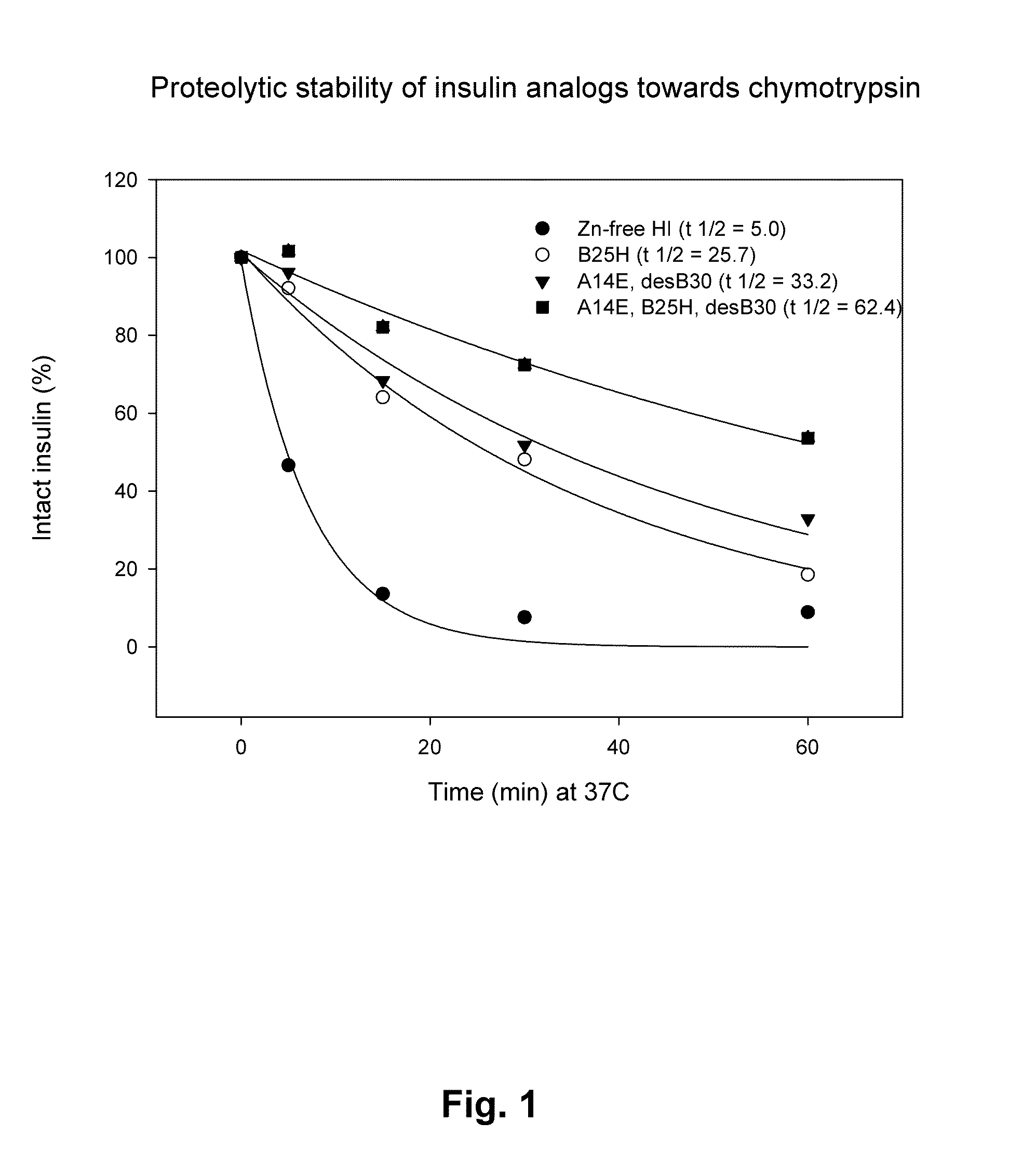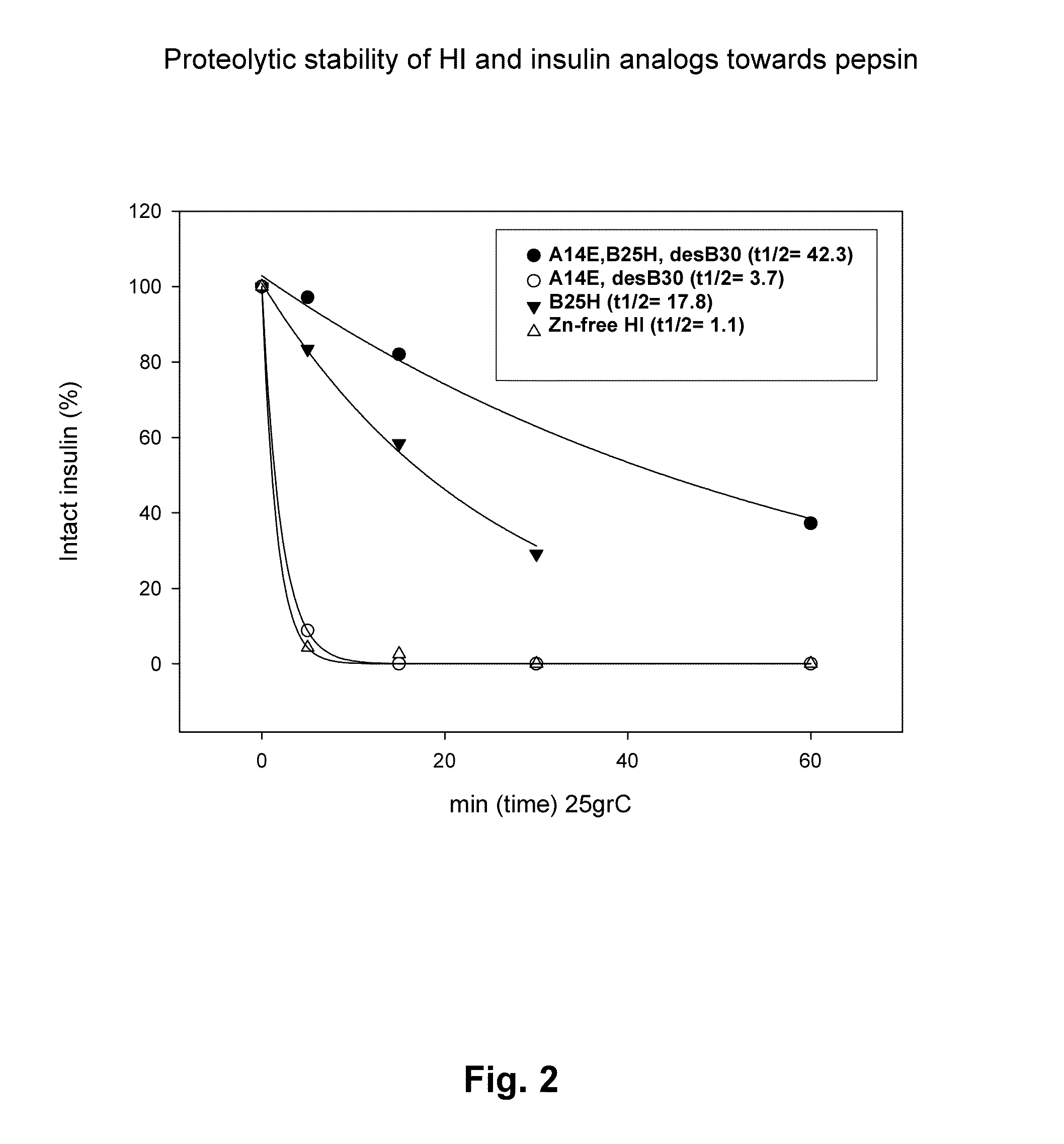Protease resistant insulin analogues
a technology of protease resistance and insulin, which is applied in the field of protease resistance insulin analogues, can solve the problems of inconvenient parenteral administration, low bioavailability, and limited administration of therapeutic peptides or proteins, and achieves the effect of retaining biological insulin activity and enhancing proteolytic stability
- Summary
- Abstract
- Description
- Claims
- Application Information
AI Technical Summary
Benefits of technology
Problems solved by technology
Method used
Image
Examples
example
Example 1
Comparison of Proteolytic Stability (Half-Life) of B25H, A14E, A14E_B25H and Human Insulin Towards Pepsin, Chymotrypsin, and Carboxypeptidase A
[0424]Proteolytic stability of human insulin and insulin analogues (0.06 mM, 10 μL) towards chymotrypsin or pepsin (0.34-3.4 μg) was measured after incubation in 100 mM NH4HCO3, pH 8.1 or 10 mM HCl, pH 2.0, respectively and 25° C. at a final volume of 100 μL. At various times (0, 5, 15, 30 and 60 min) samples were quenched with an equal volume of 0.5%TFA or 0.1 M TrisHCl, pH 8.0 (final pH 7.7) and transferred to 5° C. Human insulin and insulin analogues were immediately analyzed by RP-HPLC at 214 nm and the area under the peak corresponding to intact protein was determined.
[0425]Stability of human insulin and insulin analogues (0.06 mM, 13.9 μg) towards carboxypeptidase A (6.8 μL of working solution, 20 mg / ml, 53 units / mg, Sigma C-9268) was measured after incubation in 5 mM NaP,140 mM NaCl, 70 ppm Tween20, pH 7.4 and 37° C. at a fina...
example 2
Identification of Protease Cleavage Sites within Insulin by MS Analysis and Enzyme Specificity
[0427]Identification of protease cleavage sites were carried out by time course analysis of limited proteolysis of insulin and insulin analogues by various enzymes (pepsin, chymotrypsin, carboxypeptidase A) by LC-MS. Generated peptide fragments were identified by MS or MS / MS and quantified at 214 nm in order to identify minor and major cleavage sites (hot-spots). The following hot-spots for pepsin (B24-25, B25-26, B26-27) and chymotrypsin (B16-17, B24-25, B25-26, B26-27, A14-15 and A19-20) within human insulin were identified. Interestingly, the hot-spots overlap with insulin-degrading enzyme (IDE), see below, and cathepsin D (Hanne Refsgaard, Novo Nordisk A / S, personal communication).
[0428]Cleavage sites within the insulin sequence was also predicted based on enzyme specificity of chymotrypsin, trypsin and insulin-degrading enzyme (IDE) as shown below in example 3. The predicted cleavage s...
example 3
Repeated Cycles of Hot-Spot Identification within A14E, B25H, desB30 Human Insulin
[0429]Major hot-spots for chymotrypsin cleavage (B16-17, B24-25, A19-20) and minor cleavage sites (B1-2, B6-7),were identified in A14E, B25H, desB30 human insulin according to the method described in example 2. Insulin analogues were designed based on the identified cleavage sites and predicted cleavage sites from the enzyme specificity. Amino acid residues for substitution were selected in order to remove the cleavage sites and to increase the solubility.
Chymotrypsin, Analogue Design Based on Hot-Spots Identified by LC-MS of Digests of A14E, B25H, desB30 Human Insulin:
[0430]A14X1 B25H desB30X12 HI B1X2 B6X3 B16X6 B24X8 A19X11[0431]X1=E / D / H / Q / N / S / T / M / P[0432]X2=E / D / H / Q / N / S / T / M / P / native aa[0433]X3=E / D / H / Q / N / S / T / M / P / native aa[0434]X6=E / D / H / Q / N / S / T / M / P / native aa[0435]X8=E / D / H / Q / N / S / T / M / P / native aa[0436]X11=E / D / H / Q / N / S / T / M / P / native aa[0437]X12=desB30 / native aa
Note: substitution of B24 and / or A19 in human in...
PUM
| Property | Measurement | Unit |
|---|---|---|
| concentration | aaaaa | aaaaa |
| concentration | aaaaa | aaaaa |
| volume | aaaaa | aaaaa |
Abstract
Description
Claims
Application Information
 Login to View More
Login to View More - R&D
- Intellectual Property
- Life Sciences
- Materials
- Tech Scout
- Unparalleled Data Quality
- Higher Quality Content
- 60% Fewer Hallucinations
Browse by: Latest US Patents, China's latest patents, Technical Efficacy Thesaurus, Application Domain, Technology Topic, Popular Technical Reports.
© 2025 PatSnap. All rights reserved.Legal|Privacy policy|Modern Slavery Act Transparency Statement|Sitemap|About US| Contact US: help@patsnap.com


